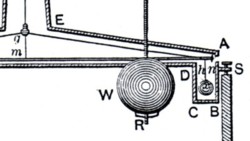Cavendish experiment
| Advanced search |
- About 5 results found and you can help!
The Cavendish experiment, performed in 1797–98 by British scientist Henry Cavendish, was the first experiment to measure the force of gravity between masses in the laboratory, and the first to yield accurate values for the gravitational constant.Many sources state erroneously that this was the first measurement of G (or the Earth's density), such as Plantilla:Cite document. There were previous measurements, chiefly Bouguer (1740) and Maskelyne (1774), but they were very inaccurate (Poynting 1894)(Encyclopædia Britannica 1910).</ref> Because of the unit conventions then in use, the gravitational constant does not appear explicitly in Cavendish's work. Instead, the result was originally expressed as the specific gravity of the Earth, or equivalently the mass of the Earth; and were the first accurate values for these geophysical constants. The experiment was devised sometime before 1783 by geologist John Michell, who constructed a torsion balance apparatus for it. However, Michell died in 1793 without completing the work, and after his death the apparatus passed to Francis John Hyde Wollaston and then to Henry Cavendish, who rebuilt the apparatus but kept close to Michell's original plan. Cavendish then carried out a series of measurements with the equipment, and reported his results in the Philosophical Transactions of the Royal Society in 1798.
- See also: Wikipedia
- Related: Schiehallion experiment
| Sideways Gravity in the Basement, The Citizen Scie... Sideways Gravity in the Basement, The Citizen Scientist, July 1, 2005 www.sas.org/.../index.html - Web |
| Measuring Big G, Physics Central Measuring Big G, Physics Central www.physicscentral.com/explore/action/bigg-research.cfm - Web |
| The Controversy over Newton's Gravitational Consta... The Controversy over Newton's Gravitational Constant, Eöt-Wash Group, Univ. of Washington www.npl.washington.edu/eotwash/experiments/bigG/bigG.html - Web |
Average relevance
| Model of Cavendish's torsion balance Model of Cavendish's torsion balance www.scienceandsociety.co.uk/results.asp?image=10314095 - Web |
| Weighing the Earth Weighing the Earth www.juliantrubin.com/bigten/cavendishg.html - Web |
